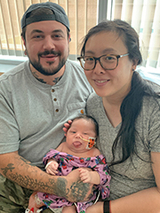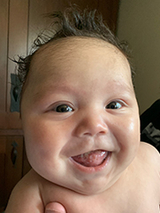Hyperinsulinism and Beckwith-Wiedemann Syndrome During the Pandemic: Dominic’s Story
Hyperinsulinism and Beckwith-Wiedemann Syndrome During the Pandemic: Dominic’s Story
When Pamela and Kevin first understood that Children’s Hospital of Philadelphia (CHOP) — 2,300 miles away from their Bay Area home in California — would be the best place for their newborn son, Dominic, to receive the specialized care he needed, there was the briefest moment of hesitation.
It was mid-May, when the COVID-19 pandemic was just starting to ease on the East Coast.
“Initially, I was scared because I knew Philadelphia had been a hot spot,” Pamela says. “But once I got there, it was a different story. From keeping COVID away to knowing everything about Dom’s conditions, I knew we were in excellent hands.”
Two genetic disorders
Dominic was born with Beckwith-Wiedemann syndrome (BWS), a genetic overgrowth disorder that occurs in approximately 1 in 11,000 births. BWS is characterized by a heavy birthweight —Dom was 10 pounds — hemihypertrophy (when one side of the body is larger than the other) and macroglossia (larger-than-normal tongue).
About Beckwith-Wiedemann syndrome
Doctors at his birth hospital recognized the signs of BWS and immediately tested his blood sugar since hypoglycemia is another common characteristic, with up to 50% of children with BWS also having low blood sugar due to hyperinsulinism (HI), another genetic disorder. Of those, about 20% have severe hypoglycemia (low blood sugar) that doesn’t respond to traditional treatments.
Dominic’s blood sugar was low, really low, “like zero,” his mom says. Normal newborn levels average 55 to 65 mg/dL, and extremely low levels can trigger seizures and life-threatening or life-limiting brain damage. The usual blood sugar boosters — dextrose, glucagon, diazoxide — didn’t help Dominic much or for very long. It was clear he’d need care by experts in hyperinsulinism.
CHOP the place with hyperinsulinism expertise
Doctors at their home hospital knew of the HI expertise in the Congenital Hyperinsulinism Center at CHOP.
“They started talking to CHOP early on and got help managing his sugar levels while we waited for approvals to come to Philadelphia,” Kevin said.
Mom and baby safely traveled via a medical flight on May 22; dad drove cross-country, not wanting to fly commercially at that time.
What they found at CHOP was calm confidence, both about following all protocols recommended by the Centers for Disease Control and Prevention when it came to COVID-19, and about bringing world-class expertise to babies like Dom with HI and BWS.

In fact, as Dom went through testing and examinations in preparation for his eventual surgeries, Pamela and Kevin were thrilled with the family-centered approach to COVID-19 precautions at CHOP. In California, only one parent at a time could be with the baby and they had to always wear a mask. At CHOP, both parents could be in Dom’s room at the same time, and when no staff members were present, they could remove their face masks.
“We were so happy to be with him, together, and with no masks,” Pamela says. “It made it easier to bond with him. Back home, he had never seen our faces without a mask and only one of us could be with him at a time.”
Genetic test results confirming Dominic’s dual diagnoses came while he was under the care of inpatient endocrinologist Katherine Lord, MD, for his HI and geneticist Jennifer Kalish, MD, PhD, for the BWS.
Two successful surgeries
To treat Dominic’s hyperinsulinism, Surgeon-in-Chief N. Scott Adzick, MD, MMM, performed a 98% pancreatectomy. Two and a half weeks later, Jesse Taylor, MD, Chief of the Division of Plastic, Reconstructive and Oral Surgery, performed a tongue reduction (hemiglossectomy) to make it easier for Dom to feed. Both surgeries were successful. Six weeks after the family had arrived in Philadelphia, it returned to the West Coast, by car, with a much healthier baby.
While Pamela and Kevin still test his glucose regularly, Dom’s blood sugar levels are in the normal range and he doesn’t require any dextrose or medications to keep them there. The gut-gripping fear of dangerously low blood sugars is gone.
“We know we’re lucky,” she says, “since many babies need dextrose or meds after most of their pancreas is removed.”
And his feeding is going great. “He has a good appetite and takes the bottle with no problem now,” she says.
Follow-ups in his future

Because of his BWS, Dominic has an elevated risk of developing several types of cancerous and noncancerous tumors, especially during childhood, so he will have regular monitoring scans.
They know it is near certain that Dom will develop diabetes eventually, and that he may need to take medications containing digestive enzymes for pancreatic insufficiency, both a result of having a near-total pancreatectomy.
“We plan to come back to CHOP every six months to a year so they can monitor him,” Pamela says.
“Right now, he’s doing great. It’s like night and day, comparing now to before we came to Philadelphia. He smiles all the time and is happy every day. It’s all because of CHOP. We’re so thankful.”